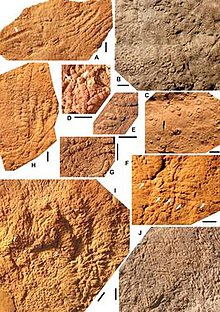Not to be confused with Tunisia.
| Funisia Temporal range: Ediacaran, about 555 Ma PreꞒ Ꞓ O S D C P T J K Pg N ↓ | |
|---|---|

| |
| Funisia specimens, as illustrated in the original article | |
| Scientific classification | |
| Kingdom: | Animalia |
| Phylum: | incertae sedis |
| Genus: | †Funisia Droser & Gehling, 2008 |
| Binomial name | |
| †Funisia dorothea Droser & Gehling, 2008 | |
Funisia is a genus of animal containing the single species F. dorothea. It is an extinct animal from the Ediacaran biota, discovered in South Australia in 2008 by Mary L. Droser and James G. Gehling.
Description
Funisia, a sedentary animal resembling an upright worm, stood about 0.3 m (1 ft 0 in) tall. Because individuals grew in dense collections of animals the same age, it is believed to have reproduced sexually, as well as reproduced by budding like modern sponges and corals. Although the evolution of sex took place before the origin of animals, and evidence of sexual reproduction is observed in red algae 1,200 million years ago, Funisia is one of the oldest known animals for which there is evidence of sexual reproduction.
Its relationship to other animals is unknown, but it may belong within the Porifera (sponges), Cnidaria, a basal metazoan similar to sponges or an early varisarcan vendobiont.
The genus and species were described in a 2008 paper.
Etymology
The generic name Funisia is after the Latin "rope", and is pronounced to rhyme with Tunisia. The name dorothea is in honour of Dorothy Droser, the mother of Mary L. Droser, one of the scientists who studied the organism.
See also
References
- ^ Mary L. Droser; James G. Gehling (21 March 2008). "Synchronous Aggregate Growth in an Abundant New Ediacaran Tubular Organism". Science. 319 (5870): 1660–1662. doi:10.1126/science.1152595. PMID 18356525. S2CID 23002564.
- ^ Smith, Lewis (21 March 2008). "Fossil sheds light on the history of sex". The Times. London. Archived from the original on 27 July 2008. Retrieved 3 May 2010.
- ^ "Early life on Earth - no predators, plenty of sex". Reuters. 21 March 2008.
- ^ "Research shows Earth's earliest animal ecosystem was complex and included sexual reproduction". 20 March 2008. Source: University of California - Riverside via physorg.com
- Butterfield, N. J. (1 September 2000). "Bangiomorpha pubescens n. gen., n. sp.: implications for the evolution of sex, multicellularity, and the Mesoproterozoic/Neoproterozoic radiation of eukaryotes". Paleobiology. 26 (3): 386–404. doi:10.1666/0094-8373(2000)026<0386:BPNGNS>2.0.CO;2. ISSN 0094-8373. S2CID 36648568. Retrieved 16 June 2021.
- D. H. Erwin, M. Laflamme, S., M. Tweedt, E. A. Sperling, D. Pisani, and K. J. Peterson. 2011. The Cambrian Conundrum: Early Divergence and Later Ecological Success in the Early History of Animals. Science 334(6059):1091-1097
- Cavalier-Smith, Thomas (5 February 2017). "Origin of animal multicellularity: precursors, causes, consequences—the choanoflagellate/sponge transition, neurogenesis and the Cambrian explosion". Philosophical Transactions of the Royal Society B: Biological Sciences. 372 (1713): 20150476. doi:10.1098/rstb.2015.0476. PMC 5182410.
- Supporting online material
| Taxon identifiers | |
|---|---|
| Funisia dorothea | |